Superbowl
For owls that are superb.

US Wild Animal Rescue Database: Animal Help Now
International Wildlife Rescues: RescueShelter.com
Australia Rescue Help: WIRES
Germany-Austria-Switzerland-Italy Wild Bird Rescue: wildvogelhilfe.org
If you find an injured owl:
Note your exact location so the owl can be released back where it came from. Contact a licensed wildlife rehabilitation specialist to get correct advice and immediate assistance.
Minimize stress for the owl. If you can catch it, toss a towel or sweater over it and get it in a cardboard box or pet carrier. It should have room to be comfortable but not so much it can panic and injure itself. If you can’t catch it, keep people and animals away until help can come.
Do not give food or water! If you feed them the wrong thing or give them water improperly, you can accidentally kill them. It can also cause problems if they require anesthesia once help arrives, complicating procedures and costing valuable time.
If it is a baby owl, and it looks safe and uninjured, leave it be. Time on the ground is part of their growing up. They can fly to some extent and climb trees. If animals or people are nearby, put it up on a branch so it’s safe. If it’s injured, follow the above advice.
For more detailed help, see the OwlPages Rescue page.
view the rest of the comments

Oh! Sorry, I meant only if the information was handy. I don't know whether you shorten the name in the cause of title brevity.
TBH, I've only gotten nerdy about the WFS. I've become quite partial to the species. I could certainly start posting pictures I find, but I'm always concerned about duplication: my memory for whether I've seen an image before, and whether it was in the community or not, is poor. I suppose I could have made the comment about N v S WFS a post... ah well. Next time.
Oh, I wasn't bothered or anything, just joking with you.
I will typically include any info I do get, plus I'll throw in any context I feel might be necessary. I've never given you guys any less of anything. Sometimes I'll blur a face or remove a paragraph about donations, but that is all.
I don't know if I've taken the time to listen to much WFS sounds. If you find sound or video clips to share that highlight the differences, that would be neat to see, or if there's some differences in feathering or something else.
The only sound I found recently though was very cute! I checked the votes, as I shared it as a reply to someone else and it looked like you may not have seen it, so here it is!
I did! In my response are three links: the first is to an article describing the differences, with pictures (TBH I found it difficult to see three visual differences, but they're described); the second two contain audio clips of the calls of each of the two WFS. They're very distinctively different, for how much alike they look.
That site (ebird.org) is a great resource, by the way; it's a standard format for each bird, with descriptions and audio clips, like a ornithology dictionary.
My mistake, I didn't scroll far enough. I was distracted by the photos.
You are correct, there is no mistaking the one can from the other! The Southern's bubbling call was my favorite.
I stared at more pictures and still can't tell them apart. One may be darker, but with every pic having different lighting, I feel that's not the best thing to go by. I thought the Northern had more white on the belly, but then other pics seem to have a stripped belly.
I agree, the Southern's is mine, too, probably because it's so distinctive. I fancy that I like the look of the Southern just a touch more; not that I can distinguish them unless they're side-by-side. But that call! It's so interesting they're so similar looking but so distinctively sounding!